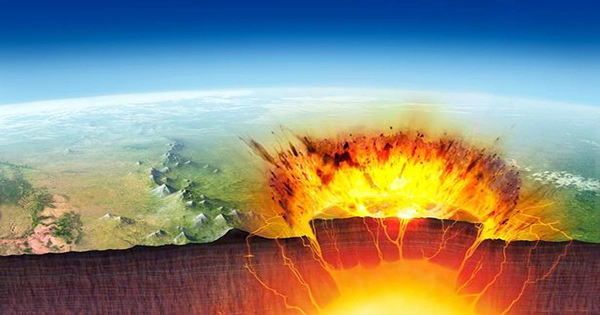As a result of the Yellowstone supervolcano’s history of producing some of the greatest known eruptions, there is obviously a great deal of interest in keeping track on its activities. But is it feasible to foretell the exact moment the volcano would erupt again?
Despite being dormant at the moment, the enormous supervolcano that supports Yellowstone National Park is thought to be active.
Scientists believe that Yellowstone has the potential to erupt in the future because of the presence of hot, fluid or semi-fluid material (magma) beneath the earth as evidenced by the abundance of hydrothermal features and frequent seismic activity in the region. The most recent volcanic eruption at Yellowstone was a lava flow that happened about 70,000 years ago.
However, despite assertions from some places that an eruption is overdue, scientists have not found any indicators that one is about to happen.
A big volcano with at least one eruption of magnitude 8 or higher—the maximum rating on the Volcanic Explosivity Index—is referred to as a supervolcano.
In the previous two million years or so, the Yellowstone supervolcano, which is situated in northwest Wyoming, has witnessed three enormous explosions that were among the greatest eruptions recorded in human history. Around 2.1 million years ago, 1.3 million years ago, and around 631,000 years ago, respectively, these eruptions took place, forming the caldera—massive craters that develop when a volcano erupts and collapses—that exists today.
Numerous lesser eruptions took place between the massive explosion 631,000 years ago and the lava flow 70,000 years later.
Given Yellowstone’s past and the availability of magma, it is probable that another eruption may take place in the future; however, neither scientists nor the general public are certain of when or how this will happen. Aside from the fact that there is no direct method to view what is happening beneath a volcano, the irregularity of these eruptions makes them impossible to forecast.
Having said that, in the last 20 years or so, eruption forecasting has substantially improved, and there are now a number of indicators scientists may watch for that may be clues of an impending eruption.
Using a variety of real-time monitoring systems, scientists at the Yellowstone Volcano Observatory (YVO) are constantly scanning the area for such indications.
Strong earthquake swarms and swift ground deformation are two possible indicators, both of which are frequently observed in the days and weeks prior to an eruption.
Scientists anticipate that in the event of a catastrophic eruption, the time leading up to it would be marked by extreme activity much beyond usual background levels in numerous areas throughout the Yellowstone supervolcano. Weeks, months, or even years in advance, there may be indications of a catastrophic eruption.
The Yellowstone region regularly sees ground movement, numerous tiny earthquakes, and other types of geological activity as a result of the magma beneath the surface. However, as long as these processes do not deviate too much from normal ranges, they are not thought to be a precursor to an impending eruption.
Seismographs are used by YVO scientists to monitor seismic activity. Ground deformation, or movement of the Earth’s surface, is monitored using a combination of GPS and InSAR (Interferometric Synthetic Aperture Radar) satellite-based methods. InSAR measures a vast region at one time, whereas GPS measures horizontal and vertical motions at a given location.
This movement, in particular the uplift or elevation of the ground, may indicate that magma is moving toward the surface, however it is not always a warning that an eruption is about to occur. Without ever erupting, many volcanoes, especially calderas like Yellowstone, exhibit symptoms of uplift and subsidence over a long period of time.
For instance, in Yellowstone, ground uplift can result from things other than magma moving upward, such a buildup of water or gas.
To better understand what motion corresponds with typical long-term trends and what might be a sign of an impending eruption, scientists continue to track this type of ground movement at Yellowstone.
According to Kari Cooper, professor and chair of the University of California, Davis Department of Earth and Planetary Sciences, “the ground surface at Yellowstone is moving all the time, sometimes up and sometimes down, and it would not be cause for concern unless it was outside the normal patterns.”
A hotspot in the Earth’s mantle, which is a region of abnormally high temperatures, is located above the Yellowstone supervolcano and causes the material there to melt. Eventually, the resultant magma drains into a chamber under Yellowstone.
Inaccurate claims were made recently in a Facebook video claiming Yellowstone Park had been shut down due to increased volcanic uplift, implying that this was a harbinger of an impending eruption. In addition to the fact that the park was open, Yellowstone’s ground has also been deflating recently.
“Only if we saw a really significant uplift”—for instance, the ground rising feet in weeks or months—”would it be anything that we considered would be a hazardous development,” said Michael Poland, scientist-in-charge at the YVO, to the AP.
Giant supervolcano eruptions are difficult to anticipate because they vary so much in terms of their quickness of commencement, duration of eruption, and triggering processes, among other things, according to a study published in the journal Nature Reviews Earth and Environment last year.
The biggest explosive volcanic eruptions on Earth, these catastrophic “supereruptions” take place about once per 100,000 years on average.
The study discovered that they can begin gradually over a period of weeks or months before intensifying or starting out quickly. Individual supereruptions, meanwhile, can happen over a span of days to weeks or even decades. Additionally, there is a wide range of triggering mechanisms.
While past giant eruptions help to define a supervolcano, they are not necessarily a good indicator of how a given volcano will behave in the future, the researchers said.
For instance, a hydrothermal eruption, which is characterized by strong explosions that expel steam, water, mud, and rock, would most likely occur if and when Yellowstone erupted once more.
The most likely kind of volcanic eruption would be lava flows. These could come in a wide range of sizes and with or without explosive phases. The worst-case scenario, though, would be a massive supereruption, even though there is very little chance that such an occurrence will take place in any given century.
Although highly rare, such a catastrophe would result in the ejection of enormous amounts of ash and debris into the atmosphere, possibly having an impact on the earth’s climate. But given the inherent uncertainties, it’s even conceivable that an eruption of this size won’t happen again in Yellowstone.
Other recent studies have looked at the processes occurring underneath in the Yellowstone area, offering light on the volcano’s propensity to erupt.














